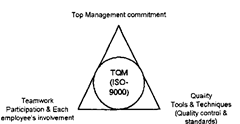20.1.
Introduction
Over a period of time, man has realised that it is advisable and more economical to buy quality products. In the present day when the plants have become complex and large, nobody can afford to have unreliable equipment since outage of one small portion of plant could mean shut down of complete costly plant. To achieve the present day quality of products, industry has witnessed several phases. There was time when customers were expected to, and wise customers were prepared to pay extra for quality. However in the competitive business climate of today, quality is no longer anyone’s option but it is a positive requirement without which no organisation can survive. Today we are in the midst of quality revolution in industry and every body is enjoying the fruits of quality products.
Ordinarily, quality is referred to as customer satisfaction and fitness for use, meeting all the expectations of the buyer of goods or services. As per ISO 8402, quality is defined as “The totality of features and characteristics of a product or service that bear on its ability to staisfy stated or implied needs”. In TQM, the quality is considered as customer delight and not just satisfaction. All this is possible when an organisation plans for “Above Customer Expectations” (ABC), for which the quality has to be integrated or embedded in the culture of the organisation. TQM is today a well established science and organisations serious about it can strictly follow ISO 9000 series of International Organisation for Standardisation (ISO) of International Quality Standards or its equivalent IS-14000 published by Bureau of Indian Standards.
Developments in quality circles in industry have taken place in various phases as follows :
(i) Quality control [statistical quality control (SQC) phase]. The industry took necessary care to ensure production of quality components to the satisfaction of customer. Various important tools like quality control charts, sampling plans and other statistical techniques were adopted.
(ii) Quality Assurance Phase. While SQC phase depended on meeting quality by sorting out rejects, QA recognised that inspection alone is not the answer to achieve quality needs of the design. Thus focus shifted to procedure compliance and product conformity to specification through production and operations management, using statistical process control as a tracking tool.
(iii) Total Quality Control Phase. It attempted to expand the QA philosophy from manufacturing and production shops to other areas of the organisation with a view to create awareness of quality and participation of total staff in it. Focus got shifted from direct cost reduction and preoccupation with efficiency to the pursuit of quality through the elimination of waste and non-value added procedures and assuring continuous improvement through the refinement and expansion of quality control systems and procedures. Use of computer and
modern management techniques like “just-in-time operation” have greatly helped in achieving total quality control phase.
(iv) Total Quality management. In the case of TQM the quality control is embedded within and is driven by the culture of the organisation. TQM has emerged as the most integrated form of organisation development.
The ISO 9000 standards on quality system provide a sound base for TQM. Fig. 20.1 shows the essential features related with success of TQM. It would be seen that commitment
of top mangagement is essential. TQM must be management led, company-wide in implementation and dedicated to continuous improvement. Total involvement of each employee is essential. TQM provides an opportunity to all employees to directly participate in their work and take decisions concerning their job. People participate voluntarily in quality circles and quality improvement teams. The job satisfaction and employee satisfaction are the important outcomes of TQM implementation. The

Fig. 20.1. Essential features of TQM.
aim of TQM is that everybody connected in one way or other with the organisation, must be able to feel comfortable and realise their potential. In broader sense, TQM attempts to create a work place where humanity is respected, thus it lets the unlimited potential of human beings blossom. The third leg of triangle in Fig. 20.1 refers to quality control and standards. However, the potentials of quality tools and techniques are exploited by building an organisational culture so that quality improvements, quality development, and quality maintenance to meet full customer satisfaction at economical levels are embedded into the work and activities of the organisation.
